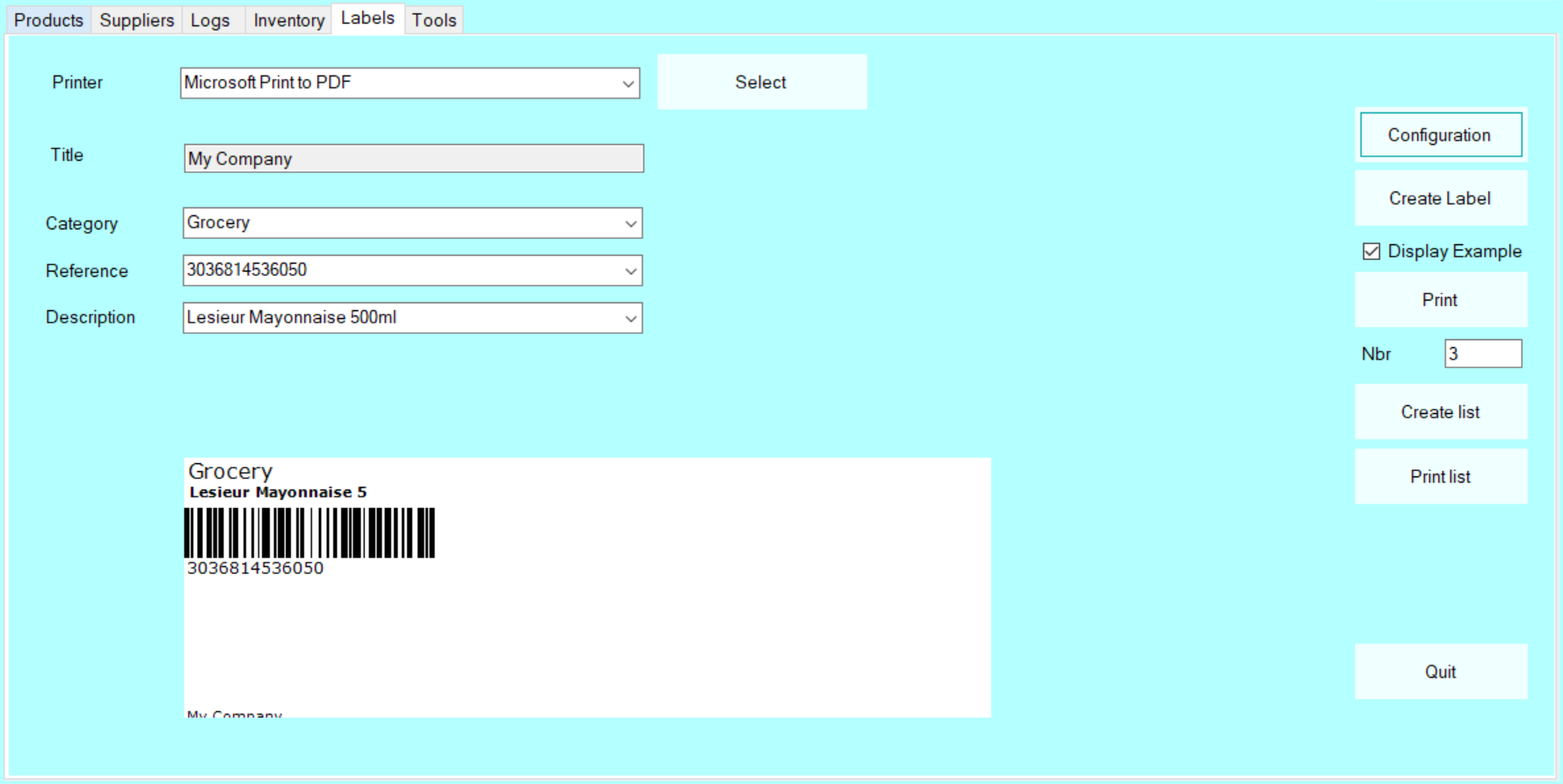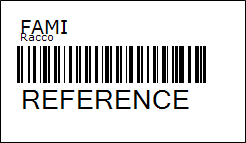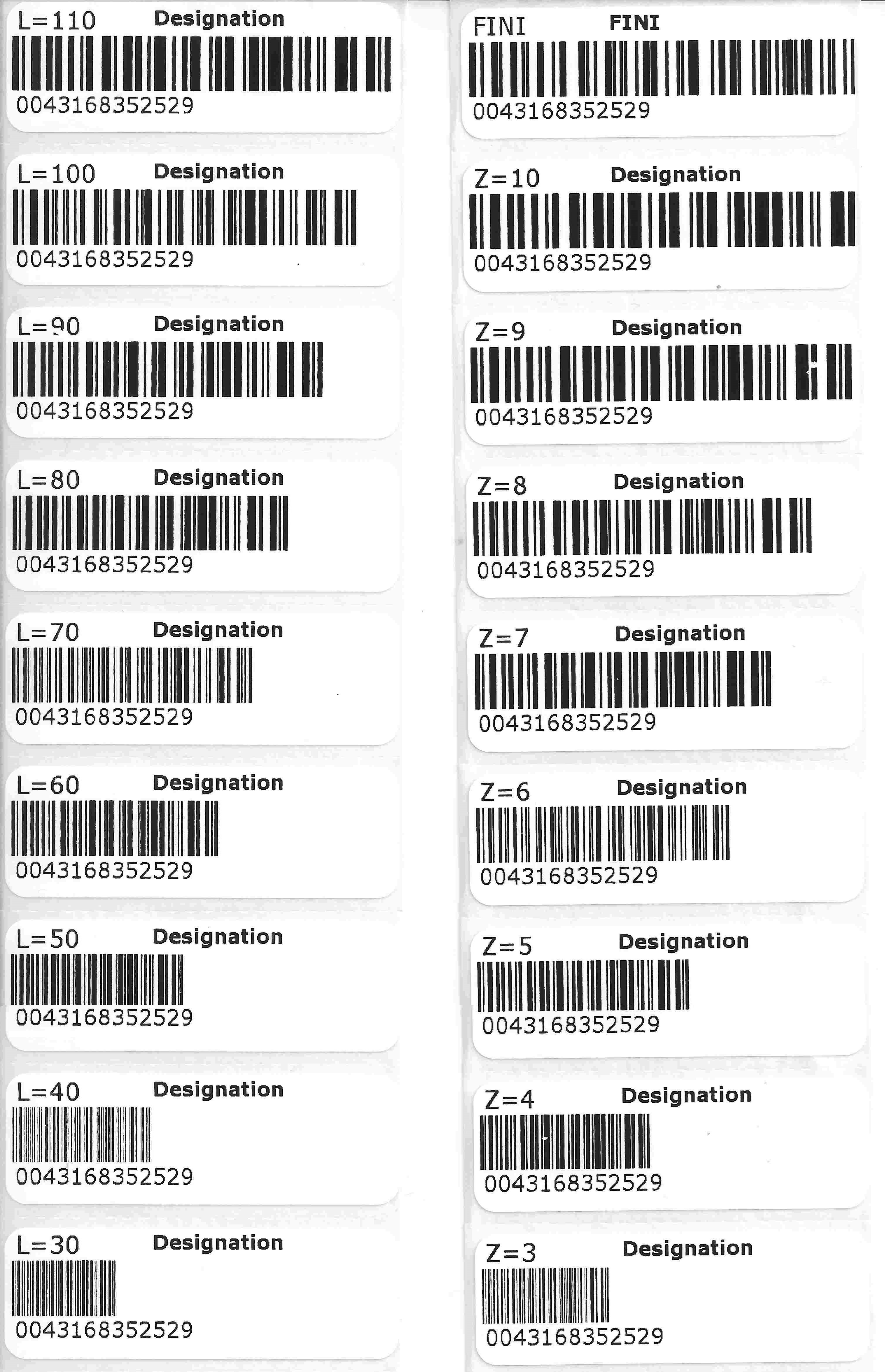The use of this tab to print labels is only available to "barcode
printing" license holders available on
www.smart-inventory-manager.com
It is important in all the following steps to distinguish between the two types of printers that you can use with SIM:
It is important in all the following steps to distinguish between the two types of printers that you can use with SIM:
- Professional label printers such as Zebra, which print labels on rolls.
- Conventional printers that print (rather poorly) sheet labels.
Display
The Labels tab is optional, and can change from one version to
another to be adapted to the many possible uses of labels.
It allows barcode labels to be printed with the references of SIM products.

The left area indicates your settings.
The central area displays a label and a label sheet as they will be printed.
The center displays a simulation of the label.
The right-hand area contains all the pushbuttons.
It allows barcode labels to be printed with the references of SIM products.

The left area indicates your settings.
The central area displays a label and a label sheet as they will be printed.
The center displays a simulation of the label.
The right-hand area contains all the pushbuttons.
Definition for the barcode
The first drop-down list allows you to select the printer to use.
Warning: to return to the Windows "default" printer you must select it when leaving this screen.
Otherwise, the usual PC users will print their documents on the labels.
The Title, Family, Description and Reference input fields are the texts that will be printed.
You can familiarize yourself with entering them manually, but the drop-down lists allow you to choose the correct labels in your database with the possibility of error.
The way in which the software will use or transform this information to reproduce it on the label and in particular for the barcode is entirely defined by the CODE128 and CODEEAN parameters of your configuration.
The Nbr box allows you to enter the number of identical labels you want to print.
Warning: to return to the Windows "default" printer you must select it when leaving this screen.
Otherwise, the usual PC users will print their documents on the labels.
The Title, Family, Description and Reference input fields are the texts that will be printed.
You can familiarize yourself with entering them manually, but the drop-down lists allow you to choose the correct labels in your database with the possibility of error.
The way in which the software will use or transform this information to reproduce it on the label and in particular for the barcode is entirely defined by the CODE128 and CODEEAN parameters of your configuration.
The Nbr box allows you to enter the number of identical labels you want to print.
Buttons
| Buttons | Action |
|---|---|
| Configuration | This button opens the layout window of a label. You have to choose the line to adjust on the left, and modify the positions with the buttons on the right. For list layout, you must modify the parameters with TOOLS/CONFIGURATION/EDIT CONFIG |
| Save | A variant of the previous button. Enables you to update the software with the layout changes. |
| Create Label | Prints a single label, and displays it, for testing |
| Prints the specified number of labels with the displayed texts | |
| Create List | Generates a CSV file containing the categories,
descriptions and references of all products. This file will enable you to print the labels in advance, without making any manual selection. |
| Print List | Enables you to print a series of labels with the data from a CSV file. With the control key pressed, the previous file is printed without having to select it a second time. |
| Quit | Exits the software. |
It is important to use the "save" button after each modification of the GSM.ini file.
A large-scale label is displayed to allow adjustments.
The format of the CSV file used for the plates is of the type "line1;line2;line3;line3;".
In general, line 3 is used for the barcode.
Configuring the simple label
This chapter describes how to define and frame a label when using a
dedicated printer, which prints from one label roll per label.
 In this example, 128 coding is used.
In this example, 128 coding is used.
The first line is fixed, the second is the product description, the reference is coded in the barcode, in the third line, in the most elaborate Code128 format.
There are nearly 40 predefined label formats.
The useful settings depend on the format used. We recommend the format Code 128=40.
Most of the configurations are optional, they have a default value.
The Etiquette.ini file contains the following parameters:
[ETIQUETTE]
NOMBRE=3 //Last printed quantity
TITRE=My Company //Last title used, line 4 on label 40
CODE128=40 //We use the 40 label format, in code128
CODEEAN=0 //We do not use the EAN codes, which are too restrictive
OFFSETX=0 // Overall offset in X
OFFSETY=0 // Overall offset in Y
ROTATION=0r> HAHAUTEUR=20 //Indicates the height of the barcode area
LARGEUR=100 //Indicates the width of the barcode area
X1=0 // X-position of the first line
Y1=0 // Y-position of the first line
L1=20 // Maximum number of digits (format 40)
F1=12 // Size of the first line font
X2=1 // X-position of the second line
Y2=10 // Y-position of the second line
L2=20 // Number of digits
F2=8B // Size of the font, B means BOLD = bold letters
X3=0 // X-position of the third line, the barcode line
Y3=20 // Y-position of the third line
X4=0 // X-position of the fourth line, optional
Y4=100 // Y-position of the fourth line
L4=20r> F4F4=8 // Font-size
ZOOM=5 // Optional Zoom setting, which replaces the barcode width
The unit is usually the half-millimeter.
The above sample provides the sample label.
There is an infinite variety of label formats, both in terms of content, shape, dimensions and fonts.
Each label has its pros and cons, and must be chosen after consultation, but can always be changed if necessary, without compromising your SIM data.
The optional zoom setting allows you to print barcodes with a fixed bar width, instead of a total width of all fixed bars.
This improves reading efficiency if necessary.

The first line is fixed, the second is the product description, the reference is coded in the barcode, in the third line, in the most elaborate Code128 format.
There are nearly 40 predefined label formats.
The useful settings depend on the format used. We recommend the format Code 128=40.
Most of the configurations are optional, they have a default value.
The Etiquette.ini file contains the following parameters:
[ETIQUETTE]
NOMBRE=3 //Last printed quantity
TITRE=My Company //Last title used, line 4 on label 40
CODE128=40 //We use the 40 label format, in code128
CODEEAN=0 //We do not use the EAN codes, which are too restrictive
OFFSETX=0 // Overall offset in X
OFFSETY=0 // Overall offset in Y
ROTATION=0r> HAHAUTEUR=20 //Indicates the height of the barcode area
LARGEUR=100 //Indicates the width of the barcode area
X1=0 // X-position of the first line
Y1=0 // Y-position of the first line
L1=20 // Maximum number of digits (format 40)
F1=12 // Size of the first line font
X2=1 // X-position of the second line
Y2=10 // Y-position of the second line
L2=20 // Number of digits
F2=8B // Size of the font, B means BOLD = bold letters
X3=0 // X-position of the third line, the barcode line
Y3=20 // Y-position of the third line
X4=0 // X-position of the fourth line, optional
Y4=100 // Y-position of the fourth line
L4=20r> F4F4=8 // Font-size
ZOOM=5 // Optional Zoom setting, which replaces the barcode width
The unit is usually the half-millimeter.
The above sample provides the sample label.
There is an infinite variety of label formats, both in terms of content, shape, dimensions and fonts.
Each label has its pros and cons, and must be chosen after consultation, but can always be changed if necessary, without compromising your SIM data.
The optional zoom setting allows you to print barcodes with a fixed bar width, instead of a total width of all fixed bars.
This improves reading efficiency if necessary.
Some settings example
LThe setup of a label is not immediate.
Above all, it must be checked that the barcode is large enough to be readable, even in the event of damage, and that it does not extend beyond the label.
To do this, use a special label, CODE128=9 to allow each print to automatically vary the two important settings:

Above all, it must be checked that the barcode is large enough to be readable, even in the event of damage, and that it does not extend beyond the label.
To do this, use a special label, CODE128=9 to allow each print to automatically vary the two important settings:
- The width if you want a constant width, regardless of the number of digits.
- The zoom if you want a better barcode, which will be of variable width

Setting up label sheets
If you do not wish to invest in a dedicated printer, you can use
adhesive sheets on a conventional inkjet printer.
You must add in the parameter file:
[ETIQUETTE]
PAS_HORIZONTAL=100 //Horizontal distance (left edge) of 2 labels
PAS_VERTICAL=50 //Vertical distance (top edge) between 2 labels
NB_HORIZONTAL=4 //Number of labels in a row
NB_VERTICAL=8 //Number of labels in a column
These settings are used with the Print List button and specify the layout of labels whose format is defined above.
If you are using a label printer, for which each label is a different page, you must set the following setting:
[ETIQUETTE]
NB_HORIZONTAL=1
NB_VERTICAL=1
You must add in the parameter file:
[ETIQUETTE]
PAS_HORIZONTAL=100 //Horizontal distance (left edge) of 2 labels
PAS_VERTICAL=50 //Vertical distance (top edge) between 2 labels
NB_HORIZONTAL=4 //Number of labels in a row
NB_VERTICAL=8 //Number of labels in a column
These settings are used with the Print List button and specify the layout of labels whose format is defined above.
If you are using a label printer, for which each label is a different page, you must set the following setting:
[ETIQUETTE]
NB_HORIZONTAL=1
NB_VERTICAL=1
Zebra Printer
Zebra printers have a lot of quality, but the ergonomics of the
software provided is catastrophic.
By default, the driver (EPL) is installed, which must then be replaced manually from the printer manager.
You may also have a label calibration problem.
You must then launch the configuration utility from the CD.
Automatic label feed configuration will last the life of your printer.
If the printer is not properly installed on Windows, check that the port is a USB port.
By default, the driver (EPL) is installed, which must then be replaced manually from the printer manager.
You may also have a label calibration problem.
You must then launch the configuration utility from the CD.
Automatic label feed configuration will last the life of your printer.
If the printer is not properly installed on Windows, check that the port is a USB port.
Code 128 Labels
The most commonly used code is code 128, which enables, for example,
upper and lower case letters.
There are about twenty formats already integrated in SIM.
Using another format means that you will be charged for the work.
The printed data are for instance:
Title : common text for all labels, for instance the name of your company.
Category, reference, description, internal reference of the product.
Location, batch number or best-before date of the product.
Some labels seem identical, but different in the way they are processed or filtered by SIM beforehand.
Starred labels are customized for specific customers.
Formats Code 128 predefined by SIM
In your configuration file, put CODE128=XXX
There are about twenty formats already integrated in SIM.
Using another format means that you will be charged for the work.
The printed data are for instance:
Title : common text for all labels, for instance the name of your company.
Category, reference, description, internal reference of the product.
Location, batch number or best-before date of the product.
Some labels seem identical, but different in the way they are processed or filtered by SIM beforehand.
Starred labels are customized for specific customers.
Formats Code 128 predefined by SIM
In your configuration file, put CODE128=XXX